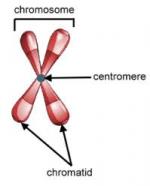|
This section contains 1,198 words (approx. 4 pages at 300 words per page) |

|
The genetic material in plants, animals, and fungi is called deoxyribonucleic acid (DNA), a long, linear polymer that is physically organized at the microscopic level into chromosomes. Chromosomes are threadlike cellular structures made up of elaborately packaged DNA complexed with proteins. When a cell reproduces itself to make two identical daughter cells, the chromosomes are replicated and divided so that each daughter cell has the same genetic and DNA content. The chromosome division process is called mitosis. During mitosis the individual chromosomes can be stained and seen under a microscope.
Genes code for the production of structural proteins and enzymes and are located at specific sites along the DNA. These sites are called loci (singular: locus) and represent a sort of chromosomal street address for the basic units of heredity, the genes. Genetic loci number in the tens of thousands for most plant species, and they are physically...
|
This section contains 1,198 words (approx. 4 pages at 300 words per page) |

|


